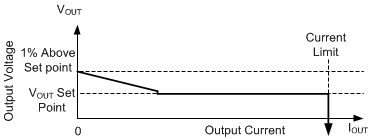SNVSC83C September 2022 – October 2025 TPSM365R3 , TPSM365R6
PRODUCTION DATA
- 1
- 1 Features
- 2 Applications
- 3 Description
- 4 Device Comparison Table
- 5 Pin Configuration and Functions
-
6 Specifications
- 6.1 Absolute Maximum Ratings
- 6.2 ESD Ratings
- 6.3 Recommended Operating Conditions
- 6.4 Thermal Information
- 6.5 Electrical Characteristics
- 6.6 System Characteristics
- 6.7 Typical Characteristics
- 6.8 Typical Characteristics: VIN = 12 V
- 6.9 Typical Characteristics: VIN = 24 V
- 6.10 Typical Characteristics: VIN = 48 V
-
7 Detailed Description
- 7.1 Overview
- 7.2 Functional Block Diagram
- 7.3
Feature Description
- 7.3.1 Input Voltage Range
- 7.3.2 Output Voltage Selection
- 7.3.3 Input Capacitors
- 7.3.4 Output Capacitors
- 7.3.5 Enable, Start-Up, and Shutdown
- 7.3.6 External CLK SYNC (with MODE/SYNC)
- 7.3.7 Switching Frequency (RT)
- 7.3.8 Power-Good Output Operation
- 7.3.9 Internal LDO, VCC UVLO, and BIAS Input
- 7.3.10 Bootstrap Voltage and VBOOT-UVLO (BOOT Terminal)
- 7.3.11 Spread Spectrum
- 7.3.12 Soft Start and Recovery from Dropout
- 7.3.13 Overcurrent Protection (OCP)
- 7.3.14 Thermal Shutdown
- 7.4 Device Functional Modes
-
8 Application and Implementation
- 8.1 Application Information
- 8.2
Typical Application
- 8.2.1
600-mA and 300-mA Synchronous Buck Regulator for
Industrial Applications
- 8.2.1.1 Design Requirements
- 8.2.1.2
Detailed Design Procedure
- 8.2.1.2.1 Custom Design With WEBENCH® Tools
- 8.2.1.2.2 Output Voltage Setpoint
- 8.2.1.2.3 Switching Frequency Selection
- 8.2.1.2.4 Input Capacitor Selection
- 8.2.1.2.5 Output Capacitor Selection
- 8.2.1.2.6 VCC
- 8.2.1.2.7 CFF Selection
- 8.2.1.2.8 Power-Good Signal
- 8.2.1.2.9 Maximum Ambient Temperature
- 8.2.1.2.10 Other Connections
- 8.2.1.3 Application Curves
- 8.2.1
600-mA and 300-mA Synchronous Buck Regulator for
Industrial Applications
- 8.3 Power Supply Recommendations
- 8.4 Layout
- 9 Device and Documentation Support
- 10Revision History
- 11Mechanical, Packaging, and Orderable Information
Package Options
Mechanical Data (Package|Pins)
- RDN|11
Thermal pad, mechanical data (Package|Pins)
- RDN|11
Orderable Information
7.4.3.2.2 Frequency Reduction
The TPSM365Rx reduces frequency whenever output voltage is high. This function is enabled whenever the internal error amplifier compensation output, COMP, an internal signal, is low and there is an offset between the regulation set point of FB/BIAS and the voltage applied to FB/BIAS. The net effect is that there is larger output impedance while lightly loaded in auto mode than in normal operation. Output voltage must be approximately 1% high when the part is completely unloaded.

In PFM operation, a small DC positive offset is required on the output voltage to activate the PFM detector. The lower the frequency in PFM, the more DC offset is needed on VOUT. If the DC offset on VOUT is not acceptable, a dummy load at VOUT or FPWM Mode can be used to reduce or eliminate this offset.